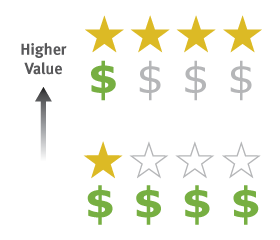Our ratings methods
Company Overview and Measure Description
About HealthPartners
Founded in 1957, HealthPartners is the largest consumer-governed, non-profit health care organization in the nation. The organization is dedicated to improving health and well-being in partnership with members, patients and the community, and provides a full-range of health care delivery and health plan services including insurance, administration and health and well-being programs. HealthPartners serves more than 1.8 million medical and dental health plan members nationwide.

Tools and resources
Measure description: Cost
HealthPartners cost ratings show how effectively medical groups and hospitals use resources for the patients they serve. These measures allow our members and purchasers to learn about and understand differences in cost and efficiency among medical groups and hospitals.
HealthPartners cost ratings are displayed on a scale of 1 to 4 dollar signs, with one dollar sign indicating lowest total cost of care. Ratings are calculated using data submitted by medical groups and hospitals that show diagnosis and treatment for HealthPartners members. Some providers do not have a sufficient number of HealthPartners patients in the area being measured to accurately assign a cost score and receive an “N/A” rating. Compared to their peers, lower-cost providers are more efficient in diagnosing and treating conditions, charge a lower fee for delivering care, or both.

Primary care
For over a decade, HealthPartners has used the Total Cost Index (TCI) to assess cost and efficiency differences among primary care groups. A provider’s TCI is a measure of efficiency, intensity and price of care delivered compared to the average for similar primary care providers. ”Total cost” includes all care, such as lab tests, x-rays and care from specialist physicians and hospitals. In 2012, this HealthPartners-developed measure became one of the first measures of resource use and cost to be endorsed by the National Quality Forum.
Specialties
HealthPartners reports cost results for Cardiology, Ear, Nose and Throat, Obstetrics and Gynecology, and Orthopedics specialties. The Total Cost Index (TCI) compares the total cost of care for patients served by each medical group and is a measure of the efficiency, intensity and price of care delivered compared to the average (e.g., cardiologists compared to cardiologists) for all costs including: hospital, professional, ancillary and pharmacy costs.
Hospitals
The HealthPartners hospital Total Cost Index (TCI) is used to measure a facility’s inpatient and outpatient total costs relative to all other hospitals. The TCI is a measure of price and efficiency for inpatient and outpatient services.
Measure description: Quality
HealthPartners quality assessment ratings are based on clinical quality as well as patient experience surveys, in which members rate quality of care and service. HealthPartners collects clinical quality measures across our regional network and also draws upon reputable third-party sources, such as Minnesota Community Measurement, that collect, analyze, and publicly report measures of clinical quality. These measures are based on standards established by organizations such as the National Quality Forum and the Institute for Clinical Systems Improvement.
HealthPartners quality ratings are displayed on a scale of 1 to 4 stars, with four stars indicating highest performance across the quality measures. Some providers do not have a sufficient number of HealthPartners patients in the area being measured to accurately assign a cost score and receive an “N/A” rating. These ratings help consumers compare providers and evaluate medical groups and hospitals on the basis of measures important to them.

Primary care
In total, 88 discrete quality measures are used in our primary care ratings, grouped into the following quality domains:
- Getting care and information: measures of access to care, such as time in the waiting room and appointment scheduling
- Care and communication: measures of physician/staff communication and satisfaction with quality of care
- Staying healthy and care for illness: measures of preventive service treatments and care for acute conditions such as colds and sore throats
- Care for chronic conditions: measures of care for specific chronic conditions, such as diabetes care
- Health information technology and generic prescribing: measures of health information technology capabilities to improve safety and experience, measures of medication safety, and use of safe effective generic drugs
Specialties
HealthPartners reports quality ratings for Cardiology, Ear, Nose and Throat, Obstetrics and Gynecology and Orthopedics, grouped into the following quality domains:
- Getting care and information: measures of access to care, such as time in the waiting room and appointment scheduling
- Care and communication: measures of physician/staff communication and satisfaction with the quality of care
- Staying healthy and care for illness: measures of preventive service treatments and care for acute conditions such as colds and sore throats
- Generic prescribing: measures of medication safety, and use of safe effective generic drugs
- Heart care and OB/GYN care (Cardiology and OB/GYN only)
Hospitals
In total, 45 discrete quality measures are used in our hospital ratings grouped into the following quality domains:
- Patient experience: patient perspectives on care and communication
- Helping patients get better: measures of care delivered supporting heart care, childbirth, pneumonia, hospital acquired infections and other care needs.
